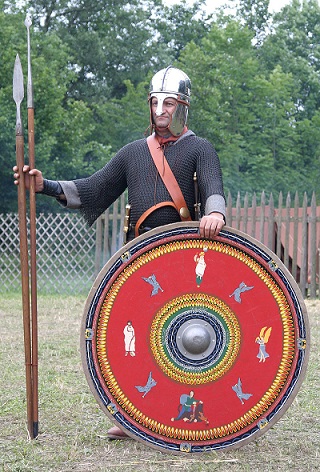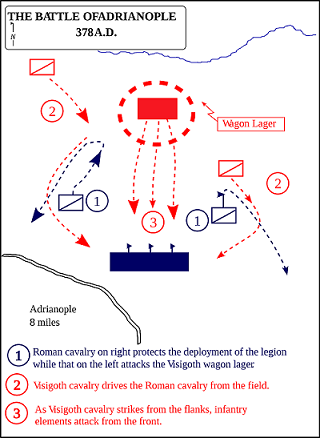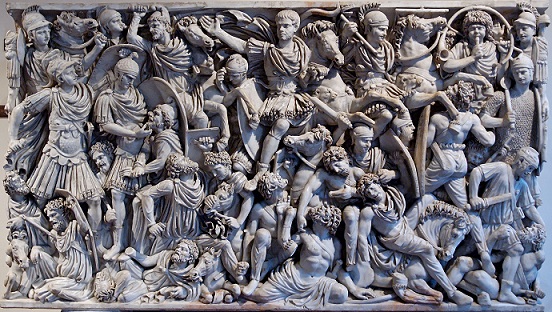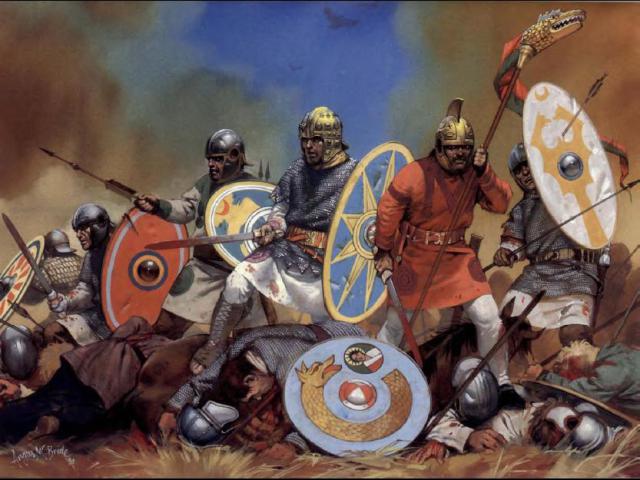During the Gothic War (376–382), a significant clash between the armies of the Eastern Roman Empire and an allied rebellion of Goths, Alans, and other locals could be considered as the beginning of the decline of the Western Roman Empire.
Near Adrianople (today’s Edirne, Turkey) the Eastern Roman Army of Emperor Valens fought against the rebels led by the Thervingian Gothic chieftain Fritigern.
Originally it is believed the tribal migration across the borders of the Roman Empire was made in a friendly manner. Greuthungi and Tervingi Goths, who saw refuge and a chance of a peaceful life away from the Huns, were originally welcomed in the Roman province of Thrace with a promise of an allied relationship.
Nevertheless, as time passed the Roman Empire began oppressing the Goths. Soon famine broke out, but the provincial leaders did nothing to help the settlers, instead making them suffer even more. The local commanders Lupicinus and Maximus exploited the tribes severely and a wave of disaffection would soon arise. In 377, the Goths revolted against the Roman military units in Thrace and defeated them.
Emperor Valens’ decision was to simply crush the spirit of the new settlers. He abandoned his campaign to the east against the Persian Empire, convinced the Goths were small in number and would be easy to deal with. He was proved wrong. For the next two years, the Empire would be in almost constant conflict with the Goths. He even asked his nephew and co-emperor Gratian to send an army to deal with the Gothic disobedience. Gratian sent his general Frigeridus leading a significant number of the emperor’s army. The Western Roman Emperor won a victory against the Goths at Alamanni.
In the end, Valens found that he had to deal with the internal turmoil in the province himself and in 378, Emperor Valens also sent his general Sebastianus on the move to regroup the Roman army deployed in Thrace, where he managed to ambush few small Gothic units.
Forces, Movement, Deployment

The day before the decisive battle, Fritigern, the leader of the Goths, sent a diplomatic envoy to the Emperor, offering a peace in exchange for a piece of land. Not unexpectedly, Emperor Valens declined the offer.
The following night, on the 9th of August, 378, Valens left the city of Adrianople, since he was informed that the Goths had built an encampment some eight miles away from the city. Leaving the city only sparsely guarded, the Roman emperor proceeded to the location of the Gothic rebel army, confident he would crush them with ease. Valens led an army of 40,000 men, strong and well-experienced war veterans.
In Valens’ army, there were probably Thracian divisions, as wells as the First and Second Imperial Armies from Constantinople, which were sent to the Persian border in 376 and to the west in 377. Altogether Emperor Valens had seven legions under his command and several imperial auxiliaries; the cavalry was comprised of horseback archers and the Imperial Guards. It is also possible the Emperor sought assistance from some of the provinces and was given melee battalions of Lanciarii and Mattiarii. In addition, he had Batavians but just for a little while, because they would flee the battle at its very beginning. Also, there was an Iberian division of mounted units and archers, led by Prince Bacurius the Iberian.
There were two Gothic armies, the Thervings – led by Fritigern – and the Greutungs, under the command of Alatheus and Saphrax. The Gothic armies were comprised of both infantry and cavalry units, where the cavalry was probably the larger portion. Mostly, historians agree that the Goths severely outnumbered the Roman forces. Valens’ ignorance of this fact was one of the main reasons for the battle’s outcome.
After a seven-hour march through difficult terrain, the Roman army was to face the Goths exhausted. At some point in the afternoon, the roman legions arrived at the Goths’ campsite, tired, disarrayed and unhappy. The Goths, who had made their camp on the top of a hill, were waiting behind a circle of wagons, together with their families.

The Battle of Adrianople
Fritigern had a strategy to delay the battle in order for his cavalry reinforcements with the other two chieftains to arrive and initiated negotiations. However, as the Romans grew irritated with the Goths they could not hold back their grudge for the roving of the Goths in the Hemus Penninsula.
The Iberian corps of the caucasian Prince Bacurius with their archers started the battle and opened fire without Valens’ command, but receiving no support were pushed back in disgrace. The left wing of Valen’s army somehow managed to reach the wagons but soon met a bigger problem. Fritigern’s plan had worked. The pre-battle delay he had created was just enough for the Greutungs’ cavalry and the Alans to join the rest.

The Gothic cavalry descended on the confused Roman army, destroying everyone in their path and forcing the Romans to retreat and regroup. The Romans lost many lives and did not manage to regain their line before the two forces clashed again. The tried, disarrayed and confused Roman troops stood no chance of regaining their position and the chaotic mess cost them their lives. Valens’ infantry and cavalry lost their morale rapidly, as the Goths slaughtered them and soaked the land with Roman blood. The Goths kept killing and massacring the Roman army until late in the evening.
About two-thirds of the Roman force was killed by the end of the bloodshed, and many of the core generals and commanders were slain on the battlefield. The Emperor Valens’ fate was no better. Possibly abandoned by his guard, he was pierced by an arrow. He either died on the battlefield or was carried to a farmhouse, which the Goths later burned to the ground with the emperor inside. It was a
It was a devastating defeat for the Empre, and brought the end of Roman domination in the known world one step closer.
